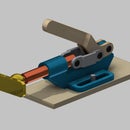Introduction: AutoDesk Inventor Sheet Metal EX3 Elliptical Transition
This exercise will introduce you to AutoDesk Inventors Basic Sheet Metal tools such as; Offset Planes, Elliptical Geometry, Lofted Flanges and the Rip command.
Step 1: Create a 2D Sketch on the XZ Plane
Create a new 2D Sketch on the XZ Plane. Create the fully constrained 2D geometry using the dimensions given in the figure and appropriate Geometrical Constraints. Make sure your rectangles center point snaps to the origin of the sketch. Finish Sketch when complete.
Step 2: Create 2D Sketch on Parallel Offset Plane
Select create 2D Sketch. When prompted to select a planar face select the XZ plane as your reference and drag your new plane off of it. The dimension required for the parallel offset is 8" and its in the positive Y direction. Once you have input the 8" dimension for the offset hit enter. You will be automatically taken into a new sketch. Create the geometry as shown in the figure. The Ellipse command is in the "Draw" tab beside "Spline" and it requires a horizontal and vertical dimension to be fully constrained in this situation. To dimension the Ellipse simply enable the dimension command, select the ellipse and move either above below or beside the geometry to determine the type of dimension to be placed. Once completed Finish Sketch.
Step 3: Create a Lofted Flange
Select the rectangular profile in sketch 1 as Profile 1. Select the Elliptical profile in sketch 2 as Profile 2. You should now have a preview. Feel free to explore the Output Options to figure out what they mean and do! Select OK to complete the feature creation.
Step 4: Rip to Allow Unfolding to Occur
Select the Rip command in the modify tab. In the rip type drop down box select point to point type of rip. Select one of the 2 larger planar faces on the side of the model as your Rip Face. Now select the point at the highest tip of that triangular face as Start Point. Now select the mid point of the lowest horizontal edge of that face as End Point. Leave the Gap Value as determined by default, Gap Size. Select OK to complete the feature.
Step 5: Create Flat Pattern
Select the planar face opposite of the rip, simply left mouse click on it to select it. By selecting that face and now selecting Go to Flat Pattern, in the top right corner of the screen, we have given the model a centralized area to create a flat pattern from. The software will unfold using the selected planar face as the center point. Your finished.













